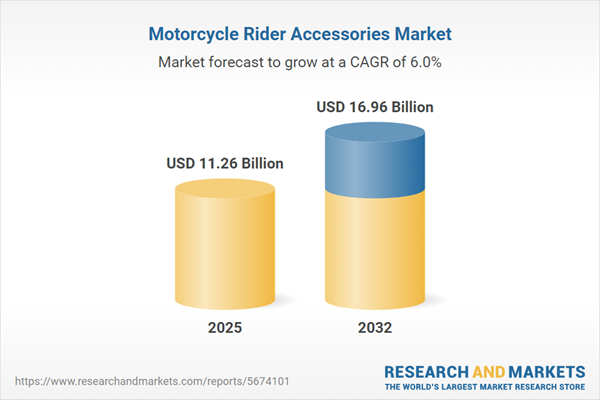Speak directly to the analyst to clarify any post sales queries you may have.
The motorcycle rider accessories market is evolving rapidly. Senior executives need to anticipate regulatory shifts, embrace technological innovation, and optimize value chains to secure resilience and sustained growth in this dynamic sector.
Market Snapshot: Motorcycle Rider Accessories Market Size and Growth
The global motorcycle rider accessories market is entering a significant phase of expansion. Industry growth is marked by advances in safety engineering, broader adoption of digital tools, and emerging direct-to-consumer sales channels. The market size is projected to increase steadily, supported by enhanced rider protection, incorporation of smart technologies into rider accessories, and the rising prominence of online sales models. A strong focus on protective gear and consistent product evolution is broadening the appeal to diverse user groups globally. The ongoing digital transformation is helping businesses adapt their offerings and align with changing consumer expectations as well as evolving regulatory requirements across different economies.
Scope & Segmentation of the Motorcycle Rider Accessories Market
- Product Types: Specialized boots designed for grip in varying terrains; Bluetooth communication devices offering connectivity and facilitating incident response; gloves crafted from leather or technical textiles for ergonomic fit and impact protection; helmets available in multiple configurations to support a range of safety needs; multi-climate jackets constructed with advanced composites, enabling comfortable riding in diverse conditions; both hard and soft luggage for optimizing storage and portability; pants made from denim, leather, or high-performance materials to suit sport, touring, and commuting styles.
- Distribution Channels: Products distributed through authorized dealerships, motorcycle retailers, mass-market retail chains, and e-commerce platforms. This mixed approach secures both traditional retail support and digital market reach, addressing acquisition preferences of a broad consumer base.
- End User Segments: Solutions tailored for urban commuters, touring and cruising enthusiasts, off-road riders seeking advanced protection, and sport riders prioritizing performance-driven gear.
- Demographics: Gender-specific and age-targeted offerings address the ergonomic requirements and style preferences of male and female riders, young adults, and mature consumers, supporting segmented marketing and product design.
- Regional Coverage: In-depth analysis is conducted for the Americas, Europe, Middle East and Africa, and Asia-Pacific regions, evaluating local consumer behaviors, compliance frameworks, and channel preferences to inform region-focused strategies.
- Leading Companies: Alpinestars S.p.A., Dainese S.p.A., Fox Head, Inc., REV’IT B.V., Klim Technical Riding Gear LLC, HJC Korea Co., Ltd., Shoei Co., Ltd., Arai Helmet Ltd., AGVSPORT S.p.A., and Bell Sports, Inc. are recognized for their emphasis on innovation and adaptive capabilities within the motorcycle rider accessories industry.
Key Takeaways for Senior Decision-Makers
- Smart helmet technologies and integrated electronics are influencing future safety standards and prompting new directions for procurement and research initiatives.
- Stronger environmental and compliance requirements are encouraging companies to adopt sustainable sourcing methods and move toward circular supply chains.
- Direct-to-consumer and online channels provide opportunities for data-driven marketing and facilitate expansion across both established and rapidly growing geographic segments.
- Flexible portfolio management and operational adaptation enable organizations to respond promptly to local needs, differing regulatory regimes, and the shift towards personalized user experiences.
- Investments in digital transformation, research, and collaborative networks enhance market responsiveness and ensure readiness for upcoming industry shifts.
Tariff Impact on Supply Chain and Sourcing
Recent adjustments in U.S. tariff policies are driving companies to reevaluate sourcing strategies, increase supply chain transparency, and boost local procurement. These shifts help mitigate cost fluctuations and support operational continuity within complex regulatory environments.
Methodology & Data Sources
This report synthesizes extensive secondary research, expert interviews, and a balanced combination of quantitative and qualitative analysis. Robust validation processes underpin every insight, ensuring reliability for executive decision-making and strategic planning.
Why This Report Matters
- Equips leadership teams with actionable intelligence to drive resource-efficient decisions, strengthen market positioning, and address evolving risks.
- Maps shifting consumer needs, technology advancements, and channel strategies to reinforce sound investment and operational priorities.
- Offers practical guidance for preparing organizations to navigate technology disruptions, regulatory developments, and heightened competition, bolstering flexibility and sustainability.
Conclusion
Leveraging this report’s insights will support business leaders in driving growth, enhancing adaptability, and strengthening competitiveness as the motorcycle rider accessories market continues to pivot and progress.
Additional Product Information:
- Purchase of this report includes 1 year online access with quarterly updates.
- This report can be updated on request. Please contact our Customer Experience team using the Ask a Question widget on our website.
Table of Contents
3. Executive Summary
4. Market Overview
7. Cumulative Impact of Artificial Intelligence 2025
List of Figures
Samples

LOADING...
Companies Mentioned
The key companies profiled in this Motorcycle Rider Accessories market report include:- Alpinestars S.p.A.
- Dainese S.p.A.
- Fox Head, Inc.
- REV’IT B.V.
- Klim Technical Riding Gear LLC
- HJC Korea Co., Ltd.
- Shoei Co., Ltd.
- Arai Helmet Ltd.
- AGVSPORT S.p.A.
- Bell Sports, Inc.
Table Information
| Report Attribute | Details |
|---|---|
| No. of Pages | 192 |
| Published | October 2025 |
| Forecast Period | 2025 - 2032 |
| Estimated Market Value ( USD | $ 11.26 Billion |
| Forecasted Market Value ( USD | $ 16.96 Billion |
| Compound Annual Growth Rate | 6.0% |
| Regions Covered | Global |
| No. of Companies Mentioned | 11 |









